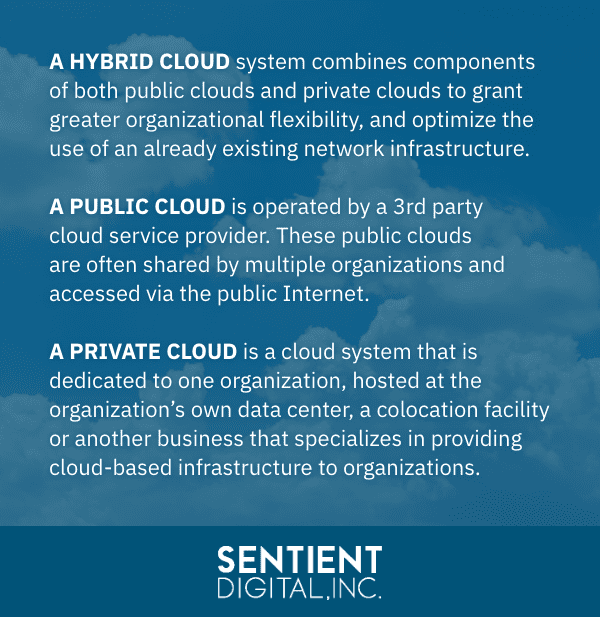Cloud computing is the next step in the modernization of information technologies across the world, and a cloud migration case study may be helpful in making the transition. To stay relevant in the cyber arms race, the United States Department of Defense (DoD) has expressed interest in cloud technology and the optimization of its networks across the military and its associated entities.
This desire for modernization is where our partnership with the Military Sealift Command (MSC) was born. The MSC is a civilian-operated vessel network which provides support to the U.S. Navy and its vessels. Sentient Digital has been contracted to strategize and conduct the transition of the MSC’s network infrastructure to a cloud-based system.
MSC Cloud Migration Case Study: Introduction to MSC
Military Sealift Command is just one of the many organizations that will benefit from the transition to cloud-based technology in the coming years. The modernization of an enterprise’s network is an all-hands operation that requires cooperation from every party and stakeholder involved in that organization’s activities.
Without complete cooperation from every part of an organization, the transformation from older network technologies to cloud-based ones will not be successful. Sentient Digital understands this, and has created a five flight strategy to facilitate the smooth transition to a hybrid cloud system for the Military Sealift Command.
What is Cloud Computing?
Cloud Computing is a form of infrastructure as a service (IaaS), which is the delivery of computing services such as analytics, data storage, and intelligence over the Internet. The purpose of migrating to cloud computing is infrastructure optimization, reduced costs, and increased flexibility. Working with an infrastructure that does not reside on a centralized server rack in your company’s headquarters can dramatically decrease time and financial resources spent on the acquisition of computing services for your organization.
Benefits of Migrating to the Cloud
The adoption of cloud computing services offer many advantages to organizations looking to make the switch.
- Cost: Cloud computing is inexpensive compared to the antiquated method of harboring racks of servers to build your organization’s network. Receiving these services over the Internet results in an immeasurable reduction in cost, and is a more efficient way to spend your organization’s network infrastructure budget.
- Security: Cloud services providers need to have robust security measures in place to ensure the safety of their clients’ data. Outsourcing your computing services and infrastructure to an entity dedicated to supplying these services in a safe and secure manner could help prevent any future vulnerabilities associated with an organization building and running its own network.
- Risk Mitigation: This is one of the main advantages to Iaas and SaaS (software as a service). The absence of enormous upfront costs present in traditional networks allows for reduced risk when building your organization’s infrastructure- this means that spreading out the costs of software as IaaS and SaaS do provides the financial space necessary for the further investment into network security measures for your enterprise.
- Scale: Investing in cloud computing allows for elasticity of scale. This means that as an organization, you only need to invest in the IT services that you require during any given period, with the constant possibility of expansion. Additionally, cloud-based services can be accessed from anywhere; this is an advantage gained over traditional, LAN-based systems.
- Reliability: Advancements in cloud-based technology and network infrastructure have allowed for increased reliability of those services. Data protection and security specifically have become easier with the ability to automatically back up and store data with multiple redundancies across the cloud provider’s network.
Transitioning to cloud-based computing services is a transformational move for any organization, and even with its many benefits, it must be handled with care.
Cloud Migration Best Practices
When migrating to the cloud, following these best practices ensures the smooth transition of an organization’s infrastructure and the security of all data involved.
- Make a Plan: Your cloud migration plan should address the following questions. What is your organization trying to achieve by migrating computing services to the cloud? Are you looking to optimize your data storage and access? Are you trying to further your cybersecurity practices and improve threat remediation? Cloud computing is a useful tool for every one of these ends, but it is important for your organization to identify why migrating to the cloud is the correct choice.
- Train Your Employees: Often the largest security risks come from inside the organization. Providing proper training to your employees in preparation for the migration to IaaS will work to prevent any potential issues born from misuse.
- Establish Security Policies: Security policies tailored to the cloud will ensure that employees take the correct measures to prevent the endangerment of confidential data. Remember that these policies must be continually updated and employees trained to keep up with evolving security risks.
Following these best practices will ensure any organization’s smooth implementation of cloud technologies in day-to-day operations. While process optimization and technological advancement are important, keeping your employees in the loop and up-to-date on company security policies is an essential step in altering your organization’s network infrastructure. Organizations should constantly look for ways to improve vulnerability remediation when dealing with large changes to their network. A cloud migration case study may prove useful in understanding how this works in practice.
Military Sealift Command Cloud Migration Case Study
The Military Sealift Command (MSC) comprises approximately 125 civilian-operated vessels that conduct missions including replenishing Navy ships and transporting specialized military cargo around the world. In addition to this, MSC’s two Network Operations Centers (NOC) provide global communications services to their ships.
MSC is included in the umbrella of entities that the Department of Defense wishes to include in the cloud migration portion of their official digital Modernization Strategy. This cloud migration case study will focus on this operation and how it pertains to MSC’s current situation and the strategy in place to advance their network infrastructure to the cloud. This migration is an extension of Sentient Digital’s partnership with the Military Sealift Command, one flourishing since 2019 when SDi was awarded a contract to provide information technology engineering support to the organization.
Vision
The United States Department of Defense (DoD) has established a goal to bring cloud computing to the military, taking advantage of the availability, redundancy, and reliability that the medium provides. In accordance with this, Sentient Digital has been awarded a contract to modernize the network infrastructure of the Military Sealift Command.
This vision encompasses the objective of migrating the following services to the cloud: Internet Access, Email, Telephony, Naval Messages, Domain Name System (DNS), Internet Protocol (IP) Transport, and Computer Network Defense (CND) services.
Execution
The goal is to migrate MSC to a hybrid cloud system. A hybrid cloud system combines components of both public clouds and private clouds to grant greater organizational flexibility, and optimize the use of an already existing network infrastructure.
A public cloud is operated by a 3rd party cloud service provider. These public clouds are often shared by multiple organizations and accessed via the public Internet. Users pay for these services as a subscription on a per-period or per-use basis.
A private cloud is a cloud system that is dedicated to one organization. This cloud system can be hosted at the organization’s own data center, a colocation facility (a large collection of data centers used by multiple organizations), or another business that specializes in providing cloud-based infrastructure to organizations.

MSC’s transition to a hybrid cloud solution would begin with acquiring the systems engineering and cybersecurity support services for the transition of the MSC Maritime Network Operations Center-East (MNOC-EAST) physical servers from Hyper-V to VMware. This transition required the effort of multiple stakeholders in their ongoing cybersecurity and engineering endeavors to provide a coherent path forward for the modernization of MSC Ashore services.
Sentient Digital proposed an agile iterative approach to construct an initial Private Cloud infrastructure, which will enable the virtualization of current NOC services as well as assist with preparation for future cloud integration and the ease of transition to a hybrid cloud system. The agile iterative approach consisted of three “sprints,” each containing their own measures and initiatives necessary to bring MSC’s network infrastructure to the cloud.
- Sprint One: Sprint one included the transition of physical servers to VMware in the development environment.
- Sprint Two: Sprint two encompassed the transition of virtual servers from Microsoft’s Hyper-V to VMware in the Development Environment.
- Sprint Three: The final step, sprint three, consisted of the transition to the production of the Virtual Domain Forest.
Result
The result of this contract is the further modernization of the Military Sealift Command’s network infrastructure. Sentient Digital has provided the hybrid cloud solution as the answer for the Department of Defense’s desire to bring efficient networking capabilities to the tactical edge, in accordance with its official Digital Modernization Strategy.

Bring Your Enterprise to the Cloud
Sentient Digital has developed industry-leading knowledge and experience in the modernization of network infrastructures, and prides itself on increasing enterprise productivity and optimization of workflow through technological means. Sentient Digital is veteran-owned and operated, and works to assist other organizations, in the government, military, or private sector, to achieve their optimization and security goals. If you’re up for the challenge and would like to work at Sentient Digital, visit our careers page and check out this blog post for tips on how to make your application stand out. If you’re looking for support with cloud migration or other digital services, reach out to learn more.



